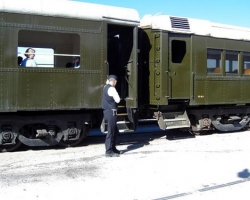I feel that I have always had an affinity for trains. There is something about rail transportation that awakens the spirit, that makes one feel he is doing something special, something romantic, perhaps, even daring.
I think, although I am not altogether sure, that I took my first train ride when slightly older than a toddler. My parents and grandmother used to tell me about a trip we once took from San Antonio to Austin. I really don’t remember that but I have seen photographs of me that were supposedly taken on a farm in Austin. I had to get there someway. Why not by train?
It wasn’t until I was a teenager that I took a train ride that I can remember, and then it was courtesy of the Navy recruiter. He sent me, and a small group of others, to Houston (from San Antonio) to take our final physicals prior to enlistment.
This, as I recall, was a simple day trip, much the same way as riding a streetcar. You sat up and looked at the scenery as you sped past. In East Texas there were not many things to see that would excite a traveler. I wish I could say that we saw fields and fields of Texas Bluebonnets or Indian Paint Brush but that was not the case. I saw those later in paintings.
The train that I remember with nostalgia and pleasure was the one that I often took from San Diego to San Antonio. It was the Southern Pacific’s Argonaut, a coal burner that left here daily and ended up in New Orleans some two or three days later.
I went over to the National City Railway Museum, the other day and spoke with the docent on duty, Jeff Trimble. I was not certain of the route out of San Diego. I knew it dipped into Mexico but did not know where.
Trimble furnished me with a tape of the route from here but only as far as Yuma. Any train leaving San Diego and going east in those days had only one track to take. It had to go over Carrizo Gorge. There I was, going over the highest railroad trestle in the world, and I did not know it.
Most of that track is now gone. It is either out of there or so covered with chaparral that it would be hard to find. That is a pity. It took so much effort and expense to lay that route. The literature tells us that progress, in some places, was measured by the inch. Of course, in other places where they had nothing but the level, desert floor in front of them, progress was measured by the mile. The tape that I have shows the route between here and Yuma as a tortuous track, much resembling a serpentine, avoiding those gorges and mountainous outcroppings of rock and, like water, seeking level or downhill ground.
In the days of my adventure on the train I was not a train aficionado or even an amateur historian. I was merely a happy, contented sailor going home after a couple of years absence and young enough to endure the rigors of a two-day train ride. The one thing that was scarce was money. There were no pullman or dining car or any of those other luxuries.
The sandwich hawkers came around the cars but even their offerings were rather dear. One could purchase a sandwich for a dollar, but, hey, a buck was a buck and could be spent on something better. So we held on until the train reached El Paso.
There was about an hour delay in El Paso. One entered Texas, part of the deep South, and certain regulations came to the fore. So while the train was being rearranged we would step off on the loading dock and discover that dinner, at last, was served. The tamale vendors were in abundance. For twenty-five cents one could buy a dozen of the tasty morsels. We gorged ourselves with enough of them to last us until we reached our destination.










